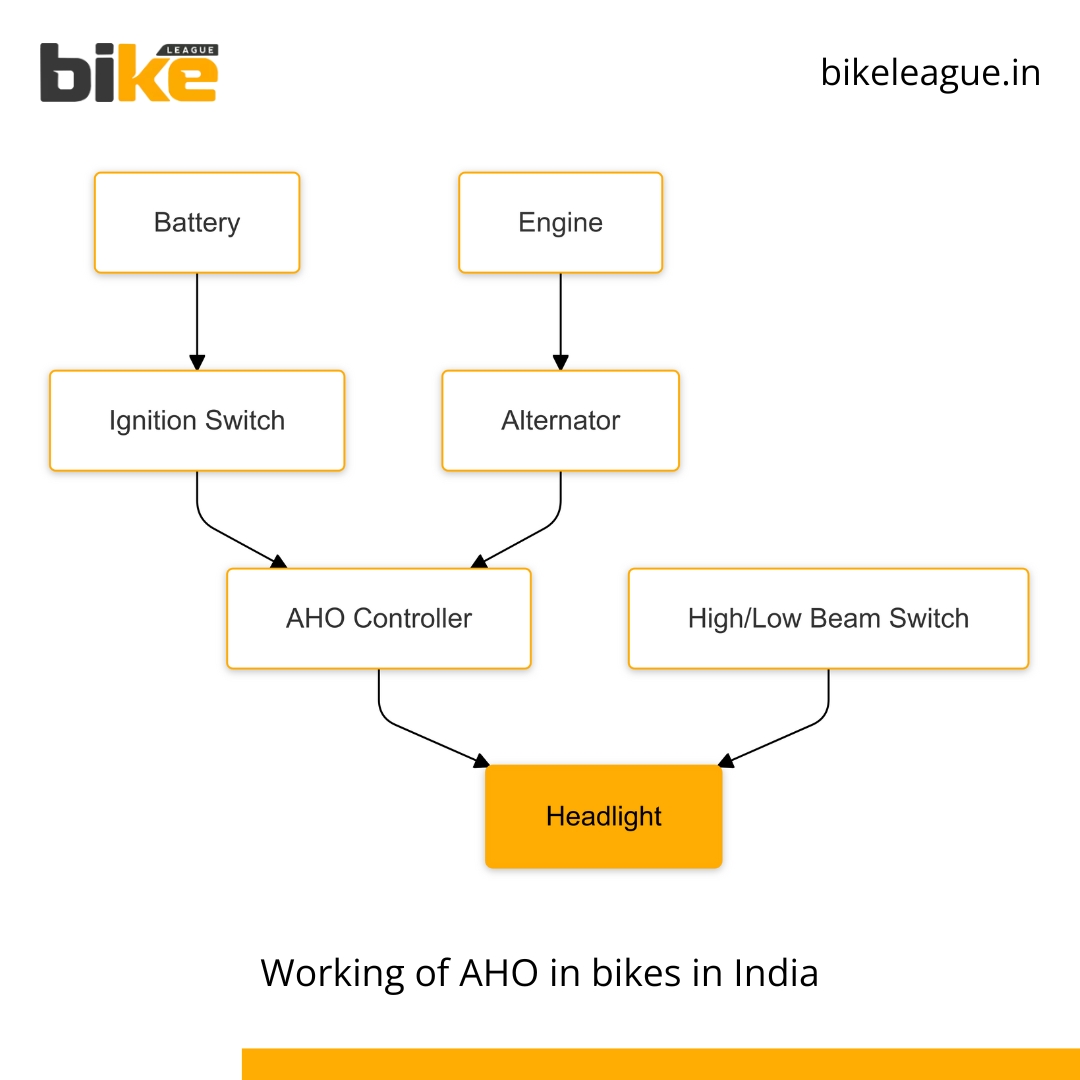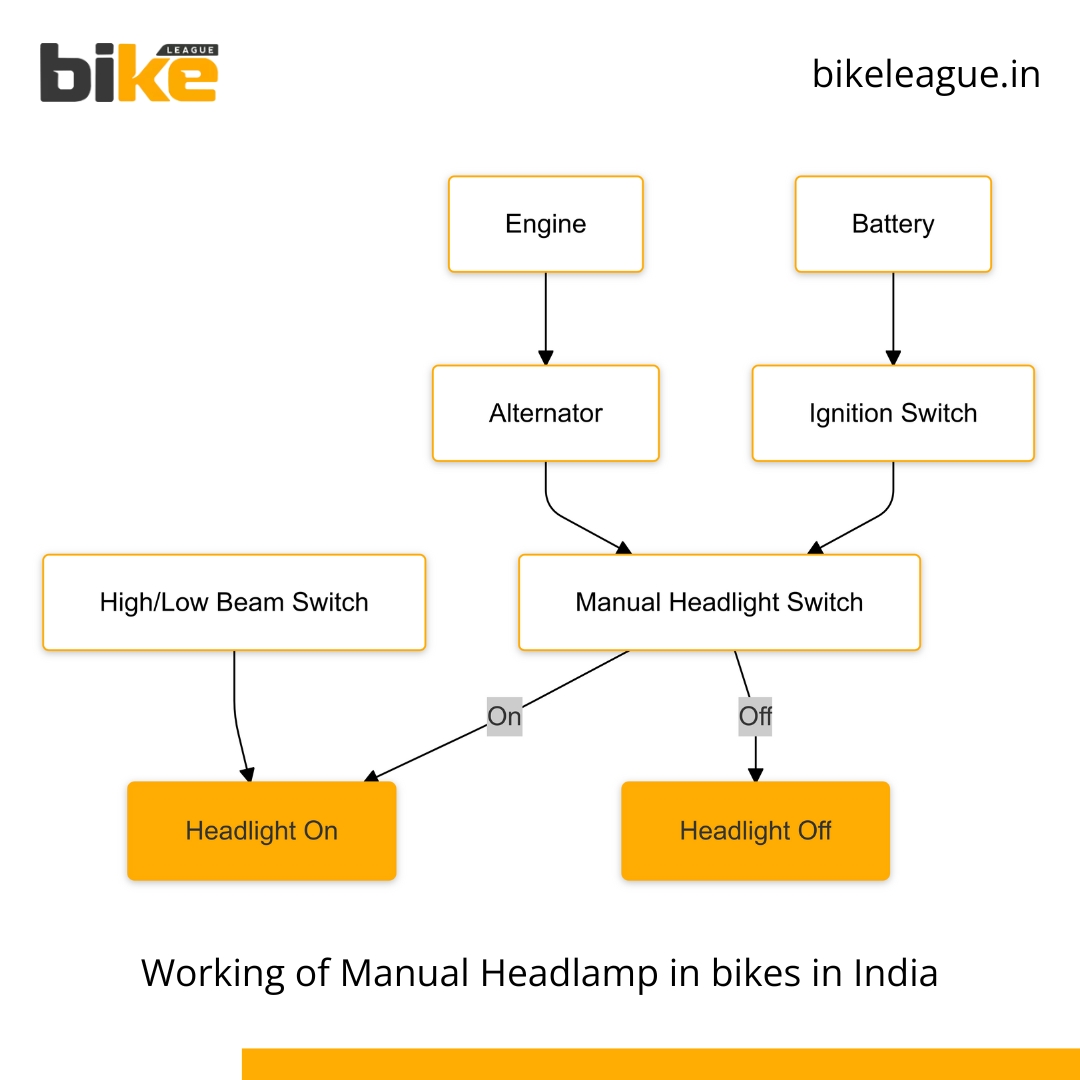
Long story short: Discover how Automatic headlamp on in bikes and scooters improves visibility and safety for Indian two-wheeler riders. Understand the regulations, public opinion, and industry response to this crucial safety feature.
Since April 2017, the automatic bike headlight feature has been a game-changer for all new two-wheelers in India. This innovative initiative has emerged as a beacon of hope, effectively combating the rising tide of road accidents and significantly enhancing road visibility, instilling a sense of reassurance and confidence in riders.
Its success in reducing road accidents is a reason for optimism in the fight for road safety. First, let’s discuss what AHO is all about, and at the end of the article, we will discuss whether or not AHO in bikes and scooters is successful or not.
What is (AHO) Automatic Headlamp On in Bikes and scooters?
AHO, which stands for Automatic Headlamp On, is a brilliant safety feature designed to make riding two-wheelers safer and more visible. In simpler terms, as soon as you start your engine, the headlamp lights up automatically, taking the guesswork out of visibility when you’re on the road. Its simplicity and convenience ensure you’re always ready to shine on the road, making your ride more comfortable and stress-free.
Here are some key highlights of the AHO feature:
- Automatic Activation: Forget about fumbling for a switch! With AHO, your headlamp turns on as soon as your engine roars to life, ensuring you’re always ready to shine on the road.
- Enhanced Safety: Whether you’re navigating through rain, fog, or winding roads, AHO significantly boosts your visibility. This means safer rides for you and everyone else on the road—after all, being seen is being safe!.
- Regulatory Requirement: Since April 1, 2017, AHO has been a mandatory feature for all newly manufactured two-wheelers in India, aligning the country with global safety standards and enhancing the overall safety of riding motorcycles and scooters.
Why Was Automatic Headlamp On (AHO) Introduced in India?
India faces a daunting challenge with one of the highest road accident rates in the world, especially among two-wheeler riders. A major contributor to this issue is the poor visibility during critical times like dawn, dusk, and foggy weather.
To tackle this pressing problem, introducing AHO (Automatic Headlamp On) has been a game-changer. This initiative has significantly enhanced the visibility of two-wheelers, making them more noticeable to other road users, from pedestrians to drivers of larger vehicles. This will ultimately help create a safer environment for everyone on the road.
Implementation and Regulations of Automatic Headlamp On (AHO)
Implementing AHO in India was part of a broader strategy to reduce road accidents and improve safety for two-wheeler riders, particularly those vulnerable in traffic. This strategy included better road engineering, stricter enforcement of traffic rules, and improved emergency response systems. The feature became mandatory for all new two-wheelers starting in April 2017, as regulated by the Ministry of Road Transport and Highways (MoRTH).
This regulatory move was significant, considering India’s position as one of the largest two-wheeler markets in the world. The regulation’s mandatory nature implies a near-universal adoption of new vehicles after implementation. However, specific adoption rates are not directly available from current sources.
How do bike and scooter manufacturers implement AHO in their models in India?
Manufacturers got creative with their designs and features to meet the new AHO requirement. Here’s a closer look at how they adapted:
1. Wiring Innovation
Direct Link to Ignition
Gone are the days of fumbling for a switch! Manufacturers now hardwired the headlamp’s electrical circuit to the ignition system, ensuring your lights flicker when you start your engine.
2. Streamlined Controls
Goodbye Manual Switch
Remember those pesky manual switches controlling your headlamp? They’ve been eliminated from all models released after 2017, paving the way for a smoother riding experience.
Simplified Control Cluster
The control cluster is now refreshingly straightforward, featuring only options for low beam, high beam, and occasionally a pass light—no more cluttered controls!
3. Lighting Upgrade
LED and Halogen Bulbs
Say hello to energy-efficient LED headlights that use less power and offer longevity. They help your rides conserve battery life and improve fuel efficiency.
Budget-Friendly Halogen Bulbs
Halogen bulbs remain available for budget models, providing a cost-effective lighting solution. However, they lack the efficiency of their LED counterparts.
4. Enhanced Electrical Systems
Powerful Alternators
To keep those headlights shining brightly at all times, manufacturers upgraded alternators to ensure a steady flow of power without straining the electrical system.
Robust Batteries
Some models now boast larger capacity batteries, ready to tackle the higher electrical demands brought by AHO.
5. Universal Compliance
AHO isn’t just for premium models—it’s a safety enhancement universally adopted across every two-wheeler category, from motorcycles to scooters and mopeds. This ensures that all riders, regardless of their ride’s price point, are considered and included in the quest for safer roads. The universal adoption of AHO is a testament to the industry’s unwavering commitment to road safety, reassuring you of the quality and safety of your two-wheeler.
6. Rigorous Testing
Manufacturers didn’t just stop at innovation; they rigorously tested headlamp brightness and beam spread to guarantee optimal visibility in various weather conditions and daylight.
7. Safety Assured
Adhering to both Indian and international standards, they made sure every headlamp meets the necessary brightness and positioning requirements for your protection.
Working of AHO Automatic Headlight On (AHO) System
- The battery serves as the system’s primary power source.
- When the ignition switch is engaged, it activates the AHO (Automatic Headlight On) controller, which automatically supplies power to the headlight.
- The alternator generates a continuous power supply while the engine runs.
- Consequently, the headlight illuminates as soon as the engine is started and remains on throughout the operation.
- Riders can adjust the headlight’s intensity using a high/low beam switch.
- However, no manual switch is available to turn off the headlight completely.
Working of Manual Switch Headlight System
- The battery is essential for supplying power to the system.
- The ignition switch is crucial in activating the electrical system.
- A manual headlight switch gives the rider control over powering the headlight on and off.
- A high/low beam switch allows the rider to switch between high and low beam settings to adapt to different driving conditions.
- There is also a flash-to-pass switch activation of the high beam.
- While the engine runs, the alternator generates continuous power to support the system’s electrical needs.
Impact of Automatic headlamp on in bikes and scooters on Road Safety
Although direct statistics on the impact of Automatic Headlamp On (AHO) systems on road safety in India are somewhat scarce, we can draw some insightful conclusions from broader trends and studies related to road safety interventions.1. A Promising Reduction in Accidents
The introduction of AHO is anticipated to significantly enhance the visibility of two-wheelers, particularly during the critical hours of dawn and dusk and in poor weather conditions. This simple yet effective measure could play a vital role in reducing road accidents.
2. Positive Road Safety Trends
A report from the World Bank highlights the effectiveness of various road safety interventions—ranging from better engineering designs and strict enforcement to improved emergency response efforts. One striking example comes from a project in Karnataka, where a remarkable 54% decline in road fatalities was observed over three years on a notoriously dangerous stretch of highway.
3. Data Collection Challenges
However, assessing the exact impact of AHO proves challenging. One major hurdle is the lack of comprehensive data on non-fatal injuries and the detailed causes behind accidents. This leaves us in a grey area, as it becomes challenging to distinguish the specific benefits of AHO from other road safety initiatives in play.
The Upside of Automatic Headlamp on in Bikes and scooters
1. Safety
Enhanced Visibility
Riders are vocal about the safety boost AHO offers by making them more visible to others on the road, especially in tricky conditions like fog, rain, or even tunnels.
Forgotten Lights No More
Gone are the days of worrying whether you’ve switched on your headlights! AHO takes away the mental load, ensuring you’re always illuminated when you need it most.
2. Convenience
Streamlined Controls
For some riders, eliminating the headlamp switch is a game-changer. No more manual toggling means a more straightforward riding experience.
Embracing Modern Tech
Younger, tech-savvy riders see AHO as an exciting advancement in vehicle safety, helping Indian bikes meet global standards.
The Downsides of Automatic headlamp on in bikes
1. Battery Anxieties
Initially, many riders feared that AHO would quickly drain their batteries, particularly in older models with halogen bulbs. But fear not! Manufacturers have responded by upgrading alternators and shifting to energy-efficient LED lighting.
2. Mileage Myths
A few riders remain apprehensive that continuously running headlamps could hurt their bike’s fuel efficiency. The reality is that the impact on mileage is minimal, yet these myths persist among some users.
3.Loss of Control
The absence of a manual option can frustrate those who love the tactile control of switching their lights.
Rider Perspectives about AHO in Different Scenarios
1. Urban Areas
In well-lit cities, some riders feel AHO is overkill, believing it may annoy other motorists.
2. Highways and Rural Roads
On open highways and dim rural roads, riders wholeheartedly appreciate the added visibility AHO brings.
3. Nighttime Rides
AHO’s benefits are less apparent at night because headlamps are expected to be on.
4. Knowledge is Key
Riders who grasp AHO’s purpose—boosting visibility and aligning with global safety standards—tend to embrace it more warmly. Those left in the dark about its benefits often dismiss it as a mere regulation.
Riders Suggestions about AHO in bikes and scooters
To improve the AHO experience, some riders have proposed the inclusion of:
1. Optional Override Switch
This feature would allow riders to switch off headlights when needed, like during stops or in well-lit areas.
2. Adaptive Lighting
How about headlamps that automatically adjust brightness or switch off based on ambient light?
Regarding safety, AHO gets a thumbs up, particularly among those who frequent highways or low-visibility settings. Views on convenience are more mixed, with some riders welcoming this modern feature while others long for the traditional control they’re accustomed to. As more riders become aware of AHO’s advantages, resistance has started to fade, and many now see it as a standard and vital feature enhancing their safety on the road.
Challenges and Controversies of AHO in Bikes in India
Despite its potential benefits, the implementation of AHO in India has faced several challenges and controversies:
- Blinding Effect of High Beams: Many riders inadvertently use the high beam setting, which can be particularly problematic with powerful LED lights, causing temporary blindness for other road users.
- Misuse of High Beam: The inability to turn off the headlamp has led to a reliance on high beams for visibility, causing discomfort and safety hazards for oncoming traffic.
- Energy Consumption Concerns: Critics argue that keeping the headlamp on at all times, even during bright daylight, is an unnecessary waste of energy.
- Mixed Consumer Feedback: While some appreciate the increased visibility, others find it inconvenient and unnecessary.
- Lack of Awareness and Education: Many riders are not adequately informed about the purpose of AHO and how to use it effectively, leading to misuse and safety issues.
Is AHO in bikes and scooters truly successful in India?
The success of AHO can be evaluated from multiple perspectives. AHO has proven its worth, from the reduction in two-wheeler accidents to its seamless integration into new models. It’s not just a feature; it’s a safety milestone. The success of AHO can be evaluated from multiple perspectives:
- Safety Outcomes: Reducing two-wheeler accidents attributable to better visibility strongly indicates AHO’s success.
- Market Acceptance: The feature’s seamless integration into new models and the gradual shift in consumer perception highlights its acceptance. It’s a regulation and a feature that riders embrace for safety.
- Regulatory Milestone: AHO represents a critical step in India’s journey toward improving road safety and aligning the country with global best practices. It’s not just a feature; it’s a testament to India’s commitment to road safety.
However, the accurate measure of AHO’s success lies in sustained efforts to raise awareness, enforce regulations, and address concerns among riders, particularly in rural and semi-urban regions.
The Path Forward for (AHO) Automatic Headlamp On in Bikes
To truly unlock AHO’s potential in the Indian two-wheeler market, we need to prioritise ongoing consumer education and foster continuous technological advancements.
This focus highlights the commitment to enhancing road safety, reminding us that improving safety on our roads is an ongoing journey that requires dedication and persistent efforts. Let’s work together to make our streets safer for everyone!
FAQ About (AHO) Automatic Headlamp On in Bikes and Scooters in India
1. How effective has AHO been in reducing road accidents involving two-wheelers in India?
While specific studies on AHO’s effectiveness in India are limited, the feature generally improves visibility. It potentially reduces accidents, especially during low visibility conditions. The Supreme Court of India has supported the proposal, emphasising its potential benefits in reducing road accidents.
2. Does (AHO) Automatic Headlamp On in bikes significantly affect the battery life?
This is a common concern among consumers. While AHO does use battery power, its impact on battery life is generally minimal when the vehicle is in motion. However, some users express concerns about increased battery usage, mainly when the vehicle is stationary for extended periods.
3. Can AHO be turned off manually, and is it legal to do so?
AHO systems are designed to operate automatically without a manual off switch. Modifying or disabling the AHO feature is not legal, as it has been a mandatory safety requirement for all new two-wheelers in India since April 2017.
4. How has AHO affected the cost of two-wheelers in India?
Implementing AHO has led to additional costs for manufacturers, which may be reflected in the price of two-wheelers. However, the research reports do not provide specific data on the cost increase due to AHO.
5. How do Indian consumers perceive the benefits of AHO compared to its potential drawbacks?
Consumer opinions on AHO are mixed. Many appreciate its safety benefits, particularly in enhancing visibility. However, some users express concerns about the inability to turn off headlamps and potential issues with battery life. Overall, there is a gradual adaptation and acceptance of the feature as awareness of its safety benefits grows.
6. How has the implementation of AHO affected two-wheeler manufacturers in India?
Manufacturers have faced challenges implementing AHO, including redesigning electrical systems and adapting production processes. They have had to balance regulatory compliance with consumer preferences and cost considerations. However, most manufacturers have successfully integrated AHO into their new models.
7. Is (AHO) Automatic Headlamp On in bikes and scooters equally effective in all weather and lighting conditions in India?
AHO is designed to improve visibility in various conditions, including dusk, dawn, and inclement weather. However, some argue that its necessity during bright daylight hours in India is debatable. The effectiveness of AHO in different weather and lighting conditions specific to India’s diverse climate is a topic of ongoing discussion.
Other related links from Bikeleague India
- Motorcycle headlight in India – Everything you need to know
- Electric scooter fire in India: Causes, Risks & Prevention
- Bike engine oil – Everything you need to know explained
- Motorcycle kill switch & key switch differences – video
- Bajaj Dominar 400
Conclusion
We hope you now know about (AHO) Automatic Headlamp On in Bikes and scooters in India. If you have questions or need more information about the AHO in bikes and scooters in India, please email us at bikeleague2017@gmail.com or leave a comment below. We’re always here and happy to help! However, don’t forget to check out Bikeleague India on our social media platforms to stay connected!



